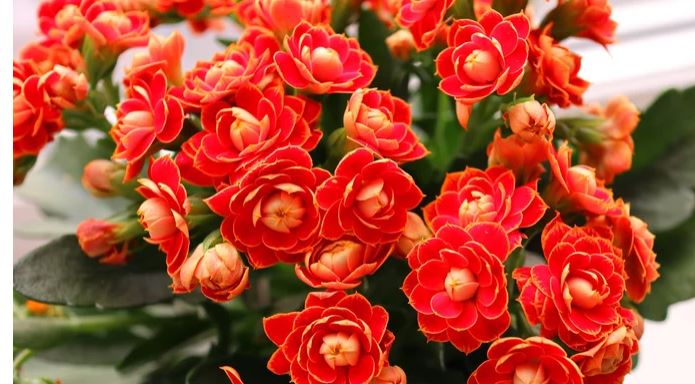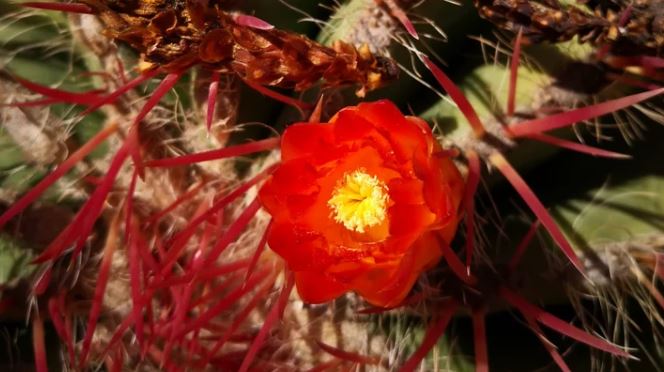
Cactus plants with red flowers bring a vibrant burst of color to arid landscapes and indoor collections. These striking blooms, ranging from deep crimson to bright scarlet, create a stunning contrast against the green or bluish-gray stems of the cacti. Their vivid hues make them a standout choice for gardeners and collectors seeking low-maintenance plants with high visual impact.
The red flowers of these cacti often bloom in spring or summer, transforming the plants into eye-catching displays. Some produce large, trumpet-shaped flowers, while others feature smaller, delicate blooms that cluster around the stems. These flowers not only enhance the plant’s beauty but also attract pollinators like hummingbirds in outdoor settings.
Caring for these cacti is straightforward, making them ideal for beginners. They thrive in bright, direct sunlight and require well-draining soil to prevent root rot. Watering should be minimal, allowing the soil to dry out completely between sessions, especially during the dormant winter months.
These cacti are versatile, fitting perfectly in rock gardens, xeriscapes, or indoor pots. Their compact sizes and unique shapes make them excellent for small spaces or as statement pieces in larger arrangements. Whether in a desert-inspired garden or a sunny windowsill, they add a touch of drama.

Why Choose Cacti with Red Flowers?
Red flowers on cacti are a rare and captivating feature. The vivid hue contrasts beautifully with the green or bluish-gray of cactus stems, creating a striking visual effect. These plants are perfect for:
- Low-maintenance gardening: Cacti thrive in dry conditions and require minimal watering.
- Aesthetic appeal: Red blooms add drama and vibrancy to rock gardens, xeriscapes, or indoor pots.
- Collector’s pride: Many red-flowering cacti are unique species or hybrids, making them prized additions to collections.
- Pollinator attraction: Red flowers often attract hummingbirds and other pollinators in outdoor settings.
Echinopsis ‘Rose Quartz’ (Hybrid)
- Description: This hybrid cactus, derived from Echinopsis species, produces large, trumpet-shaped red flowers with a glossy finish. The blooms can reach up to 6 inches in diameter and appear in late spring to early summer.
- Appearance: Globular or slightly columnar, with green stems and short spines.
- Care Tips:
- Light: Full sun to partial shade.
- Water: Water sparingly, allowing soil to dry out completely between waterings.
- Soil: Well-draining cactus mix.
- Blooming: Flowers last a few days, blooming prolifically with proper care.
Gymnocalycium mihanovichii (Ruby Ball Cactus)
- Description: Commonly known as the “Moon Cactus,” this grafted cactus features a colorful red top (often a mutant lacking chlorophyll) and produces small red or pinkish-red flowers.
- Appearance: The red top is vibrant and rounded, grafted onto a green rootstock cactus.
- Care Tips:
- Light: Bright, indirect light to avoid scorching the colorful top.
- Water: Water when the top inch of soil is dry; avoid overwatering.
- Soil: Sandy, well-draining soil.
- Blooming: Flowers appear in spring or summer, though blooming is less common in grafted specimens.
Rebutia muscula
- Description: This small, clustering cactus produces vivid red-orange flowers that cover the plant in spring. The flowers are funnel-shaped and emerge from the base.
- Appearance: Small, globular stems with fine white spines, forming dense clumps.
- Care Tips:
- Light: Full sun for optimal blooming.
- Water: Moderate watering during growing season; reduce in winter.
- Soil: Well-draining cactus soil with added grit.
- Blooming: Prolific bloomer, with flowers lasting several days.
Echinocereus triglochidiatus (Claret Cup Cactus)
- Description: Known as the Claret Cup or Hedgehog Cactus, this species produces brilliant red, cup-shaped flowers that attract hummingbirds.
- Appearance: Cylindrical stems with dense spines, forming clumps or mounds.
- Care Tips:
- Light: Full sun; thrives in hot, dry conditions.
- Water: Minimal watering; drought-tolerant.
- Soil: Rocky or sandy soil with excellent drainage.
- Blooming: Flowers appear in late spring and can last up to a month.
Mammillaria spinosissima (Red-Headed Irishman)
- Description: This cactus features bright red flowers that form a crown around the top of the plant, giving it a festive appearance.
- Appearance: Cylindrical, with white spines and a woolly top.
- Care Tips:
- Light: Bright, direct sunlight.
- Water: Water sparingly; allow soil to dry out completely.
- Soil: Well-draining cactus mix.
- Blooming: Flowers in spring, lasting several days.
Lobivia arachnacantha
- Description: A small cactus with vibrant red to reddish-orange flowers that bloom profusely in summer.
- Appearance: Globular, with short spines and a low-growing habit.
- Care Tips:
- Light: Full sun or bright light.
- Water: Water moderately in summer; keep dry in winter.
- Soil: Gritty, well-draining soil.
- Blooming: Flowers are large relative to the plant’s size and last a few days.
Echinopsis chamaecereus (Peanut Cactus)
- Description: This cactus produces bright red flowers on elongated, finger-like stems. It’s a hybrid with a sprawling growth habit.
- Appearance: Slender, green stems with soft spines, forming clusters.
- Care Tips:
- Light: Bright, indirect light or partial sun.
- Water: Water when soil is dry; avoid waterlogging.
- Soil: Well-draining cactus mix.
- Blooming: Flowers in late spring to early summer, lasting a few days.
Aporocactus flagelliformis (Rat Tail Cactus)
- Description: Known for its long, trailing stems, this cactus produces vibrant red or pinkish-red flowers along its length.
- Appearance: Long, thin stems with fine spines, ideal for hanging baskets.
- Care Tips:
- Light: Bright, indirect light or filtered sun.
- Water: Moderate watering; keep soil slightly moist in summer.
- Soil: Well-draining potting mix.
- Blooming: Flowers in spring, lasting several days.
Rebutia krainziana
- Description: This small cactus produces bright red flowers that contrast beautifully with its dark green body.
- Appearance: Globular, with short spines and a clumping habit.
- Care Tips:
- Light: Full sun to partial shade.
- Water: Water sparingly, especially in winter.
- Soil: Sandy, well-draining soil.
- Blooming: Prolific bloomer in spring and early summer.
Echinopsis ‘Los Angeles’ (Hybrid)
- Description: A hybrid cactus with large, deep red flowers that bloom in summer.
- Appearance: Globular to columnar, with green stems and moderate spines.
- Care Tips:
- Light: Full sun for best flowering.
- Water: Water sparingly; drought-tolerant.
- Soil: Well-draining cactus mix.
- Blooming: Flowers last a few days, with multiple blooms per season.
Hamatocactus setispinus (Strawberry Cactus)
- Description: This cactus produces small, red to pinkish-red flowers that resemble strawberries in color.
- Appearance: Globular, with long, curved spines.
- Care Tips:
- Light: Full sun.
- Water: Minimal watering; highly drought-tolerant.
- Soil: Rocky or sandy soil.
- Blooming: Flowers in late spring to early summer.
Gymnocalycium baldianum
- Description: A small cactus with bright red to magenta flowers that bloom in summer.
- Appearance: Globular, with smooth green skin and short spines.
- Care Tips:
- Light: Bright, indirect light or partial sun.
- Water: Water sparingly; avoid overwatering.
- Soil: Well-draining cactus mix.
- Blooming: Flowers last several days, with multiple blooms per season.
Echinocereus pentalophus
- Description: This cactus produces slender, red flowers that emerge from the sides of its stems.
- Appearance: Cylindrical stems with sparse spines, forming small clumps.
- Care Tips:
- Light: Full sun to partial shade.
- Water: Water moderately in growing season; reduce in winter.
- Soil: Well-draining, sandy soil.
- Blooming: Flowers in spring, lasting a few days.
Chamaelobivia ‘Rose Quartz’ (Hybrid)
- Description: A hybrid of Chamaecereus and Lobivia, this cactus produces vibrant red flowers on short, clustering stems.
- Appearance: Small, finger-like stems with soft spines.
- Care Tips:
- Light: Bright light or partial sun.
- Water: Water when soil is dry; avoid overwatering.
- Soil: Well-draining cactus mix.
- Blooming: Prolific bloomer in late spring to early summer.
General Care Tips for Red-Flowering Cacti
While each cactus has specific needs, here are some universal tips to ensure your red-flowering cacti thrive:
- Light: Most cacti prefer full sun or bright, indirect light. Place them near a south-facing window indoors or in a sunny spot outdoors.
- Watering: Water sparingly, allowing the soil to dry out completely between waterings. Overwatering is the leading cause of cactus death.
- Soil: Use a well-draining cactus or succulent mix, or create your own by mixing potting soil with sand or perlite.
- Temperature: Most cacti tolerate a wide range of temperatures but prefer warm days and cooler nights. Protect from frost.
- Fertilizer: Feed with a diluted cactus fertilizer during the growing season (spring and summer) to encourage blooming.
- Pests: Watch for pests like mealybugs or spider mites. Treat with neem oil or insecticidal soap if needed.
Where to Find Red-Flowering Cacti
Red-flowering cacti can be found at:
- Nurseries and garden centers: Look for specialty succulent sections.
- Online retailers: Websites like Etsy, eBay, or dedicated cactus nurseries offer a wide selection.
- Cactus and succulent societies: Local clubs often host plant sales or swaps.
- Propagation: Many cacti can be propagated from offsets or cuttings, allowing you to expand your collection.